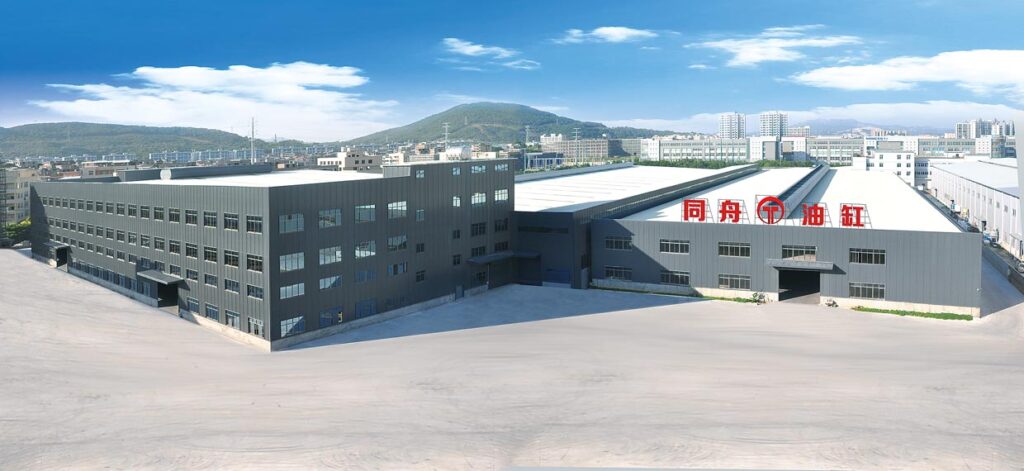The hydraulic cylinder manufacturer is a hydraulic actuator that converts hydraulic energy into mechanical energy and does linear reciprocating motion. It has simple structure and reliable operation. When it is used to achieve reciprocating motion, it can be removed from the deceleration device. And there is no transmission gap, and the movement is stable. So it is widely used in various mechanical hydraulic systems.
The output force of the hydraulic cylinder is proportional to the effective area of the piston and the pressure difference on both sides. The hydraulic cylinder is basically composed of a cylinder and a cylinder head, a piston and a piston rod, a sealing device, a buffer device and an exhaust device. Buffer devices and exhaust devices depending on the specific application, other devices are essential.
Classification of hydraulic cylinders
The structure of hydraulic cylinders is varied, and there are many classification methods:
- Piston type
A hydraulic cylinder has only one end of a piston rod. As shown in the figure is a single piston hydraulic cylinder. Both ends of the inlet and outlet oil ports A and B can pass the pressure oil or return oil to achieve two-way movement. So it is called a double-acting cylinder.
The piston can only move in one direction, and its counter-direction movement needs to be completed by external forces. But its stroke is generally larger than the piston hydraulic cylinder.
The piston hydraulic cylinder can be divided into single rod type and double rod type two kinds of structure. The fixed way by the cylinder block fixed and piston rod fixed two. According to the role of hydraulic force has single action and double action. In the single-acting hydraulic cylinder, the pressure oil is only supplied to one cavity of the hydraulic cylinder. And the cylinder is moved in one direction by hydraulic force. The opposite direction is moved by external force (such as spring force, self-weight or external load). The movement of the piston in the two directions of the double-acting hydraulic cylinder is completed by the action of hydraulic force through the two cavities alternately entering the oil.
- Plunger type
- The plunger hydraulic cylinder is a single-acting hydraulic cylinder, which can only achieve movement in one direction by hydraulic force. And the plunger return depends on other external forces or the weight of the plunger;
- The plunger is only supported by the cylinder liner and not in contact with the cylinder liner. So the cylinder liner is easy to process, so it is suitable for long stroke hydraulic cylinders;
- The plunger is always pressurized during work, so it must have sufficient stiffness;
- The weight of the plunger is often large, and it is easy to sag due to its own weight when placed horizontally. Resulting in unilateral wear of the seal and the guide, so its vertical use is more advantageous.
- Telescopic type
Telescopic hydraulic cylinder has a two-stage or multi-stage piston, telescopic hydraulic cylinder piston out of the sequence from large to small, and the order of retraction is generally small to large. The telescopic cylinder can achieve a longer stroke, while the length is shorter when retracted, and the structure is more compact. Such hydraulic cylinders are often used in construction machinery and agricultural machinery. There are many pistons that move once, and when each piston moves successively, its output speed and output force are changed.
- Swinging type
The oscillating hydraulic cylinder is the actuator which outputs torque and realizes reciprocating motion. It has several forms such as single blade, double blade, spiral swing and so on. Blade type: The stator block is fixed to the cylinder block, and the blades and rotor are connected together. According to the direction of oil, the blade will drive the rotor to reciprocate. The spiral swing type is divided into single spiral swing and double spiral, and now the double spiral is commonly used, and the linear motion of the piston in the hydraulic cylinder is transformed into the compound motion of the linear motion and the rotation motion by the two spiral pairs, so as to realize the swing motion.
Working principle of hydraulic cylinder
The hydraulic cylinder is the executive component in the hydrostatic transmission system, it is the energy conversion device which transforms the hydraulic energy into the mechanical energy. The hydraulic motor realizes the continuous rotary motion, while the hydraulic cylinder realizes the reciprocating motion. The structure type of hydraulic cylinder has three categories: piston cylinder, piston cylinder and swing cylinder.
The piston cylinder and the plunger cylinder realize reciprocating linear motion, output speed and thrust, and the oscillating cylinder realize reciprocating swing, output angular speed (speed) and torque. In addition to single use, hydraulic cylinders can also be combined in two or more or combined with other institutions. To complete a special function. The hydraulic cylinder is simple in structure and reliable in operation, so it has been widely used in the hydraulic system of machine tools.

